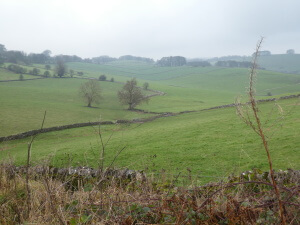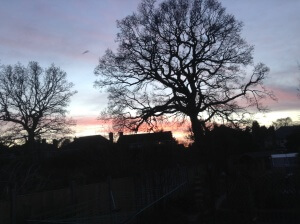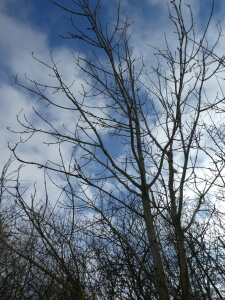When I was a little girl living on the edge of a small town, I used to climb the trees behind our houses. Until I read books by Robert MacFarlane, I thought it was an activity confined to childhood but no it is (or was?) something he enjoyed into his 40s. Trees were part of my background- in stories like The Wind in the Willows, Enid Blyton and many fairy stories. At primary school we learned how to identify trees by their leaves, bark and fruits, collecting samples for the nature table and rubbing the bark with crayons to distinguish one tree from another.
Derbyshire countryside as seen from Tissington Trail
Sadly I have lost much of that knowledge. Roselle Angwin’s online course, Tongues in Trees, has started to rectify that loss and open my mind to up-to-date research.
I have now learned:
1. In a thunderstorm ‘avoid oaks, seek beeches,’ is false advice. Any tree can be struck by lightning but because the bark of the beech is smooth, any damage is not obvious whereas the action of rain on the crinkly bark of the oak creates a series of mini waterfalls. If they are hit by lightning, the outer growth rings show the damage.
2. Deciduous trees have evolved so that in a normal winter storm, they can withstand the wind. In summer, when storms are more rare, because the trees have leaves, the trees are more liable to be blown down. Health and safety alert!
3. Scientists have long discovered that trees connect with each other through their root systems, passing nutrients to each other. Apparently trees are capable of distinguishing their roots from those of other species.
More recently it has been discovered that trees use fungi to improve their chances of survival both as individuals and as a species. The fungi can cover acres. Some kill but most seem to help. Oak milkcap helps the oak increase its nitrogen and phosphorous. In return it uses sugar and other carbohydrates from the the oak. Chanterelles feed (and are fed by) a variety of different species including birch, oak and spruce.
4. I knew that trees lived longer than us, but not how much longer. Ash and beech for example will live 200 years in favourable conditions.
In Central Europe, there are no longer old-growth forests, so extensive stands of trees are probably no more than two to three hundred years old.
However there are ancient forests in North America and Canada. In Montreal, Dr. Zoe Lindo of McGill university has identified a Sitka spruce as at least 500 years old. In Dalarna province in Sweden, by using carbon 14 dating, the oldest tree is estimated as 9,550 years old!
The yew is the longest living native tree. In Fortingall, Perth and Kinross there is one reputed to be over 2,000 years old.
The oldest oak may be a mere 500 years old.The oldest trees in the world are bristlecone pines on the high mountains of California where some are about 10,000 years old.
It puts our ‘three score years and ten’ in perspective!
5. Trees do adapt as the climate changes. After a dry spell one year, the tree can be more economical with its use of water, storing more in its trunk and using less.
Beautiful oak at the bottom of our garden is still an infant!
Obviously trees can’t change quickly like insects might, but they do adapt. When the seed is ripening in the flower, specific genes are activated that may not have been needed before. Each tree is an individual, each more genetically different than first sight suggests, so some trees change and survive, and some don’t and die.
I don’t know if modern teachers take their pupils into streets and parks where they can learn about trees. So much more is known now and there is access on the internet to that knowledge. Learning afresh brings back some of that child-like curiosity and I am glad of that.
Ash saplings in February at Ryton Pools, Warwickshire
References.
Photos have been downloaded with permission from Wikipedia where acknowledgments have been quoted. Otherwise the photos are my own.
Roselle Angwin runs online course- Tongues in Trees. Her website: https://www.roselleangwin.wild ways covers many topics including several on the environment.
The Hidden Life of Trees- Peter Wohlleben and The Wisdom of Trees- Max Adams are relatively easy to read right through or pick and choose.
The course members share their knowledge and discoveries and through them I came across a BBC documentary: My Passion for Trees about Judi Dench’s wood




Marg, I’ve just read it and I learned things I didn’t know! Thank you (and for flagging up my work). I love this pooling of knowledge – ‘hive mind’, they call it, but I’m going to call it ‘mychorrhizal mind’ – even though I suddenly doubt my spelling of that!
See you on Iona in a few weeks. Hmmm. Guess we’ll be gazing into the rookery in the crowns of the sycamores, other trees being a bit scarce there!